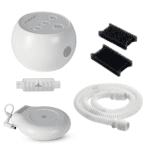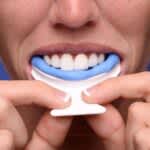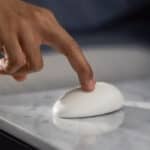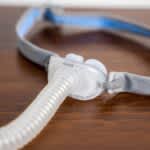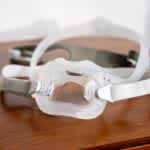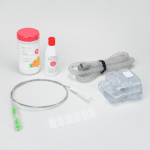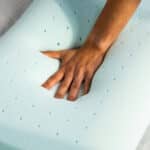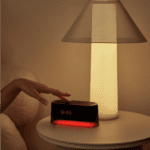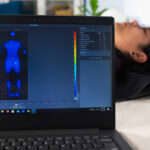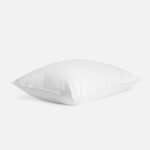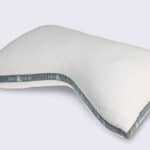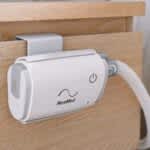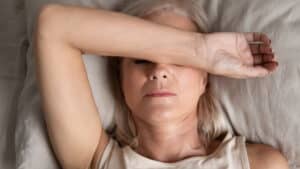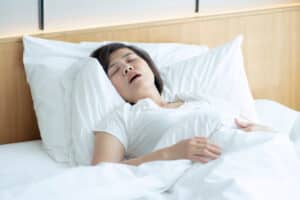Research suggests that obstructive sleep apnea is about twice as common in men than it is in women. While men are at greater risk of this sleep disorder, part of this difference may also be attributed to the underdiagnosis of obstructive sleep apnea in women and people assigned female at birth.
Obstructive sleep apnea is a condition in which the airway becomes blocked during sleep and momentarily interferes with breathing. Research related to the diagnosis and treatment of obstructive sleep apnea has long focused on how this sleep disorder occurs in men and people assigned male at birth.
Not until recently has research looked at how the symptoms, diagnosis, and treatment of obstructive sleep apnea is affected by sex and gender. Read on to learn more about obstructive sleep apnea in women, including why it may be underdiagnosed, risk factors in women and people assigned female at birth, and when to talk to a doctor.
Why Is Sleep Apnea Less Common in Women?
It’s estimated that obstructive sleep apnea affects up to 15% percent of women in the United States. Obstructive sleep apnea may be less common in women and people assigned female at birth due to differences that are specific to their sex and gender.
Sex refers to differences in anatomy, hormones, and chromosomes and is typically assigned at birth. Gender refers to differences ascribed by a person’s culture including expectations, roles, and behaviors.
Obstructive sleep apnea is underdiagnosed in women and people assigned female at birth. This means that many people have the disorder without it being recognized or treated. Several reasons may account for the underdiagnosis of obstructive sleep apnea.
- Hormonal Differences: Researchers believe that differences related to sex, including anatomy and hormones, may explain why women and people assigned female at birth are less likely to develop obstructive sleep apnea.
- Differences in Symptoms: Symptoms of obstructive sleep apnea are often different in women and people assigned female at birth, which can cause doctors to misdiagnose the condition. Additionally, since symptoms can differ by sex, women may not meet insurance criteria for needed diagnostic tests.
- Diagnostic Challenges: Even when additional testing is performed, women and people assigned female at birth may have unique results that do not meet the standards for a diagnosis of sleep apnea. At-home sleep apnea testing, which is becoming more common, is also more likely to miss the presence of obstructive sleep apnea in women.
- Stigma: Most people with obstructive sleep apnea are overweight or obese. Women with obesity often feel stigmatized in medical situations and may hesitate to engage with their doctor. Avoiding care can lead to conditions like obstructive sleep apnea going undiagnosed.
Sleep Apnea Symptoms in Women
Many women with obstructive sleep apnea don’t realize that their breathing becomes abnormal when they sleep. For this reason, it’s common for a bed partner or roommate to be the first to notice breathing issues during sleep. Signs and symptoms of obstructive sleep apnea include:
- Sleepiness throughout the day
- Loud snoring
- Gasping or choking sounds during sleep
- Headaches after waking
- Dry mouth
- Decreased sex drive
- Waking up at night to use the bathroom
While these signs and symptoms can occur in people of any sex or gender, some symptoms are more common and helpful in detecting obstructive sleep apnea in men and people assigned male at birth. For example, women with obstructive sleep apnea are less likely to report daytime sleepiness and snoring when compared to men.
Women with obstructive sleep apnea are more likely to report the symptoms of insomnia, depression, and morning headache. Women may also experience other symptoms like restless legs, nightmares, and heart palpitations.
Common Misdiagnoses for Women With Sleep Apnea
In women and people assigned female at birth, signs of obstructive sleep apnea may be mistakenly attributed to other conditions.
- Menopause: Menopause is when the ovaries stop producing hormones and releasing eggs. Obstructive sleep apnea often develops during menopause and the symptoms of obstructive sleep apnea can be mistakenly attributed to menopause.
- Depression: Depression is a mental health condition often involving feelings of sadness, emptiness, or hopelessness. Depression is a common symptom of obstructive sleep apnea in women, but a doctor may not realize that obstructive sleep apnea is the underlying cause of a person’s mental health condition.
- High Blood Pressure: Untreated obstructive sleep apnea increases the risk of high blood pressure. Doctors may detect high blood pressure in women and not recognize that increases in blood pressure are linked to undiagnosed obstructive sleep apnea.
Risk Factors for Sleep Apnea in Women
A risk factor is anything that makes it more likely for someone to develop a health condition. Many of the risk factors for obstructive sleep apnea are similar in all people, however some risk factors may have a unique impact on women and people assigned female at birth.
- Age: Age is the most significant risk factor for obstructive sleep apnea, but getting older has a more significant impact on the risk of obstructive sleep apnea in women, especially after menopause.
- Overweight and Obesity: Excess body weight is strongly associated with obstructive sleep apnea. However, women tend to develop sleep apnea at a higher body mass index (BMI) when compared to men. This means that body weight may have more of an impact on the development of obstructive sleep apnea in men.
- Facial or Airway Abnormalities: Large tonsils, a large tongue, or a thick neck can increase the likelihood of developing obstructive sleep apnea. The risk due to these abnormalities is greater in men and people who were assigned male at birth.
- Family History: Obstructive sleep apnea is more likely to occur in people who have family members with the condition. This may be related to lifestyle similarities between family members, but may also be influenced by genetic similarities that affect the anatomy of the head, neck, and face.
- Polycystic Ovarian Syndrome: Women and people assigned female at birth who have polycystic ovarian syndrome (PCOS) experience hormonal changes that make them more susceptible to developing obstructive sleep apnea.
- Hypothyroidism: Obstructive sleep apnea is more common in people with an underactive thyroid, a medical condition called hypothyroidism. Hypothyroidism is significantly more common in women and people assigned female at birth.
Effects of Sleep Apnea in Women
Getting treatment for obstructive sleep apnea is important, as untreated sleep apnea can lead to potentially serious side effects in people of any sex or gender. Potential complications of untreated obstructive sleep apnea include an increased risk of high blood pressure, heart attack, stroke, depression, and accidents related to excessive tiredness.
Research has found that obstructive sleep apnea also puts women and people assigned female at birth at a higher risk of developing thinking impairment or dementia. This is possibly due to not getting enough oxygen in the brain because of breathing disruptions.
Women and people assigned female at birth also have a higher risk of developing metabolic syndrome. Also called insulin resistance, metabolic syndrome is a group of conditions that increase the likelihood of heart disease, type 2 diabetes, and other medical conditions.
Fortunately, many of these problems in women and people assigned female at birth can be significantly improved with continuous positive airway pressure (CPAP) treatment.
When Should Women See a Doctor?
Women should talk to their doctor about the possibility of sleep apnea if they have symptoms of obstructive sleep apnea. This includes symptoms and complications that are more often reported by women and people assigned female at birth, including:
- Depression
- Insomnia
- Strong urges to move the legs when at rest
- A racing or pounding heart
- Headaches, especially in the morning
The onset of sleep apnea may be more likely during pregnancy and after menopause, so it may be especially helpful to discuss symptoms of sleep apnea with a doctor during these times.
Frequently Asked Questions About Sleep Apnea and Women
Research on the risk of obstructive sleep apnea in transgender and non-binary people is limited. However, preliminary reports suggest that gender-affirming hormone and surgical treatments may affect the risk of developing obstructive sleep apnea.
Due to this potential change in risk, experts recommend monitoring certain transgender people for obstructive sleep apnea during gender-affirming care.
Pregnancy may raise a person’s risk for obstructive sleep apnea. When a person is pregnant, the uterus takes up additional space in the abdomen, altering the space available for the lungs. Other changes in the body also contribute to a heightened risk of obstructive sleep apnea during pregnancy.
Untreated obstructive sleep apnea in pregnant people can cause a number of serious complications, including gestational diabetes, high blood pressure, premature birth, and a greater chance of needing a cesarean section.
Safe treatments are available, so it is important to discuss any symptoms of obstructive sleep apnea that may arise during pregnancy with a health care provider.
Sleep apnea is often misdiagnosed in women, so be assertive if you believe you may have obstructive sleep apnea that has been overlooked or attributed to other conditions such as menopause or depression. Ask your doctor for details about how they were able to rule out obstructive sleep apnea as the cause of your symptoms.
Sometimes, your doctor may encounter barriers to ordering a sleep study. This can occur when insurance companies base the coverage for these tests on symptoms more common in men with obstructive sleep apnea, such as daytime sleepiness. Talk to your doctor about whether there are barriers to testing in your case, and what can be done to overcome them.
Bring a friend or family member with you to a follow-up appointment. It may be especially helpful to bring a spouse, roommate, or friend who has seen you sleep, since they may have observed nighttime symptoms like snoring, gasping, or awakening. Research shows that men more often have a partner present at appointments to provide this type of information.
It may be helpful to share a log or sleep diary of symptoms which document your sleep difficulties. If your doctor previously recommended lifestyle changes to help with sleep, which is a common first step, be ready to explain what changes you implemented and the impact they had. Ask if a referral to a sleep specialist, who is specially trained to recognize sleep disorders, may be appropriate.
References
Ask the Sleep Doctor
Have questions about sleep? Submit them here! We use your questions to help us decide topics for articles, videos, and newsletters. We try to answer as many questions as possible. You can also send us an email. Please note, we cannot provide specific medical advice, and always recommend you contact your doctor for any medical matters.


